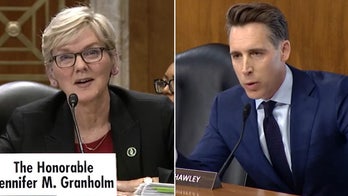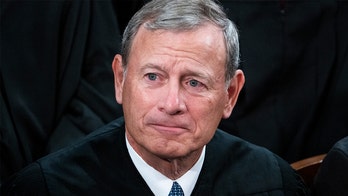Which GOP candidate appeals most to Wisconsin electorate?
Rep. Sean Duffy breaks down how voters are feeling in the Badger State
**Want FOX News First in your inbox every day? Sign up here.**
PRESENTING YOUR WISCONSIN FIELD GUIDE
In an unprecedented moment in modern politics, both American political parties have arrived at a crossroads in Wisconsin today.
Will Hillary Clinton’s struggle to quell socialist enthusiasm within her party turn harder than cheering for the Vikings at Lambeau Field? Will Donald Trump see his path to outright victory narrow to the width of a strand of string cheese?
There’s been lots of polling, much of it from reputable sources, so we have some contours for the two primary contests today. But if you really want to know how the elections will go, get to know the people.
With than in mind, here is your field guide for today’s primaries. On, Wisconsin!
[Watch Fox: After a break in the primaries, the AEHQ team is back with Megyn Kelly and Bret Baier leading tonight’s Wisconsin primary coverage.]
GOP’S HOME TURF
Wisconsin was never favorable territory for GOP frontrunner Donald Trump. While it is loaded with the older, white voters than have helped him in other states, it is also home to many college-educated and prosperous voters of the kind that have refused Trump.
But that didn’t necessarily mean that it would be favorable ground for Texas firebrand Sen. Ted Cruz, who has consistently led in recent polling. Wisconsin, of course, was originally intended to be in the column of its governor, Scott Walker, an early casualty in the GOP Game of Thrones.
And if it wasn’t Walker one would suppose that a more moderate candidate than Cruz would be Badger State Republicans’ pick. As the election shifted to be a referendum on Trump, however, Cruz’s candidacy took on new significance even to Republicans who might not have initially preferred him.
Cruz looks to Wisconsin today not just to deny Trump delegates. A delegate shutout would leave Trump to try to win 70 percent of delegates in remaining contests win outright, an unlikely achievement. That would be bad for Trump, but not necessarily good for Cruz. The Texan is looking to shoot the moon with a delegate sweep and a majority, not plurality, win to improve his own difficult delegate math.
To that end, Cruz has just as much to worry about from third-place Ohio Gov. John Kasich, who might poach delegates in more liberal precincts of the state, of which there are many.
So where will they get the votes?
--42 total delegates
--Winner-take-all
--18 awarded to the statewide winner, 24 awarded to the winners of the state’s 8 congressional districts
--Open primary
--787,847 total ballots cast in 2012
--Mitt Romney, 44 percent; Rick Santorum, 37 percent; Ron Paul, 11 percent; Newt Gingrich, 6 percent;
--Polls close at 9 p.m. ET
[GOP delegate count: Trump 737; Cruz 475; Kasich 143 (1,237 needed to win)]
BEAST OF THE EAST
Because of its immigrant history, Wisconsin differs from many states in that the Republican stronghold is closest to the biggest city. The German immigrants who turned Milwaukee into a boom town 150 years ago and gave birth to the Republican Party left a deep imprint in the city and its suburbs. This is Walker country.
While Cruz looks to excel in this region, he is fighting a two-front war. In neighboring Illinois and Michigan downscale white voters around Chicago and Detroit came out big for Trump, and we can expect the same in Milwaukee. But Cruz also has to be concerned with the moderate, mainline Republicans in places like Waukesha County.
Cruz’s best hope for a big win is that voters here listen to their governor’s plea that stopping Trump requires voting for Cruz, not just a vote against the frontrunner.
Key County: Waukesha
--Population: 396,488
--Median household income: $76,319
--Race: Caucasian, 94 percent; black, 1 percent
--Adults with bachelor’s degrees: 41 percent
--2012 election: Romney 65 percent
--Residents 65 or older: 17 percent
--Waukesha Pure Food Company created Jiffy Jell in 1916, which was later renamed to Jell-O.
[2012 Republican primary: Mitt Romney, 61 percent; Rick Santorum, 29 percent; Ron Paul, 6 percent; Newt Gingrich, 3 percent]
PRAIRIE FIRE
Rural Wisconsin is not like the rural parts of most states in that it is a Democratic stronghold. The prairie populism of neighboring Minnesota has a home with the descendants of Scandinavian immigrants here.
The Republicans who do live in the western part of the state tend to be of a defiant kind. That presents a double opportunity to Trump. Since he can hope to win populist, progressive votes that might otherwise go to Bernie Sanders but also tap into the long-standing iconoclasm of the region’s Republicans. These were Rick Santorum voters four years ago.
If Cruz can win over the iconoclasts and come out of places like Eau Claire County as well as the staunch conservative stronghold around Green Bay in a split with Trump he will have done himself well. Conversely, if Trump unites the populist progressives and the conservative fire breathers he stands his best chance to pick up at least three delegates here.
Key County: Eau Claire
--Population: 102,105
--Median household income: $48,209
--Race: Caucasian, 93 percent; black, 1 percent
--Adults with bachelor’s degrees: 31 percent
--2012 election: Obama 56 percent
--Residents 65 or older: 14 percent
--Named from the French “Eaux Claires” which means “clear water.” After spending months on the muddy Chippewa River, French explorers exclaimed this phrase when they reached the clear waters of the Eau Claire River.
[2012 Republican primary: Rick Santorum, 39 percent; Mitt Romney, 36 percent; Ron Paul, 13 percent; Newt Gingrich, 8 percent]
THREE DELEGATES AND CLOUD OF DUST
It bears repeating: Republicans who live in liberal places are generally more liberal than Republicans who live in conservative places. And there are few places more liberal than Madison, Wis. That’s very good news for Kasich. Although there are not a ton of Republican votes to be had in Dane County and its environs, they should line up well for the moderate, bipartisanship of Ohio’s chief executive.
Kasich’s bid to damage both Cruz and Trump in Wisconsin stands its best chance in the congressional district that comprises college town Madison and its suburbs. If he can win here and snag a district in the Milwaukee metro at the eastern end of I-94, Kasich can consider his Badger State foray a success.
Key County: Dane
--Population: 523,643
--Median household income: $62,303
--Race: Caucasian, 86 percent; black, 5 percent
--Adults with bachelor’s degrees: 48 percent
--2012 election: Obama 71 percent
--Residents 65 or older: 12 percent
--The dome of the state capital, Madison, is made entirely of granite making it the largest granite dome in the world.
[2012 Republican primary: Mitt Romney, 38 percent; Rick Santorum, 36 percent; Ron Paul, 17 percent; Newt Gingrich, 6 percent]
BELLWETHER: WALWORTH COUNTY
Keep your eye on this county on the Illinois border that has thrown bullseyes in the last two GOP primary election cycles.
--Population: 102,804
--Median household income: $53,998
--Race: Caucasian, 96 percent; black, 1 percent
--Adults with bachelor’s degrees: 26 percent
--2012 election: Romney 55 percent
--Residents 65 or older: 15 percent
--Known as the “Newport of the West,” early railroad access made Lake Geneva, located here, a popular vacation spot for wealthy industrialists from Chicago.
[2012 Republican primary: Mitt Romney, 52 percent; Rick Santorum, 30 percent; Ron Paul, 11 percent; Newt Gingrich, 5 percent]
WITH YOUR SECOND CUP OF COFFEE…
You probably know that the Republican Party was born in Wisconsin. But nearly as soon as it was founded, the Republican Party of Wisconsin was at odds with the national organization. In the era after the Civil War, Republicanism mostly replaced the crusading anti-slavery spirit of its founding with an embrace of economic growth and big business. By the turn of the 20th century, William McKinley’s slogan of “patriotism, protection and prosperity” pretty well summed it up. In Wisconsin, however, many Republicans stayed true to their radical roots, chief among them Robert La Follette. La Follette, who sought the governorship in 1891 on an anti-corruption crusade, was his state’s and his party’s instigator-in-chief. A radical progressive who savagely attacked his party’s leaders for corruption and coziness with business, La Follette would go on to be elected four times to the Senate. Still reviled by conservatives and revered by liberals, anti-war activists, and labor union organizers, La Follette casts a long shadow even today. Read more from the Wisconsin Historical Society.
Got a TIP from the RIGHT or the LEFT? Email FoxNewsFirst@FOXNEWS.COM
POLL CHECK
Real Clear Politics Averages
National GOP nomination: Trump 40.4 percent; Cruz 32.8 percent; Kasich 20.6 percent
National Dem nomination: Clinton 50.2 percent; Sanders 42.8 percent
General Election: Clinton vs. Trump: Clinton +10.8 points
Generic Congressional Vote: Republicans +0.5
DEMOCRATIC WISCONSIN: LABOR, LIBERALS AND THE CREAM CITY
The reason Bernie Sanders has taken a narrow lead in Wisconsin pre-election polls is the same reason that he did so well in Michigan and Minnesota last month. A strong connection to traditional labor liberalism, a healthy dose of the radical left and an overwhelmingly white population means favorable terrain for Sanders.
With an African American population of less than 7 percent and an iconic bastion of far-left liberalism in Madison, Sanders has a shot to keep his campaign aloft with a clear win in Wisconsin. Since Democrats award all their delegates proportionally, he doesn’t have a chance to substantially change the forbidding math facing his nomination. He could, though, at least claim some momentum as the race turns to his native New York on April 19.
--96 total delegates
--Proportional
--Open primary
--553,753 total ballots cast in 2012
--Barack Obama, 58 percent; Hillary Clinton, 41 percent
--Polls close at 9 p.m. ET
[Dem delegate count: Clinton 1712; Sanders 1011 (2,383 needed to win)]
BREWING FOR HILLARY
Just because there aren’t many African American voters in Wisconsin doesn’t mean they are not politically powerful, especially in Democratic primaries. Clinton’s success in contests so far this cycle has depended in a big way on black and other minority voters, and if she wins in Wisconsin, it would be no exception. Combined with moderate, traditional suburban Democrats, black voters are expected to deliver Milwaukee County and its outliers for the frontrunner.
The question for her is whether she can run up the score enough to offset expected losses elsewhere.
Key County: Milwaukee
--Population: 957,735
--Median household income: $43,385
--Race: Caucasian, 65 percent; black, 27 percent
--Adults with bachelor’s degrees: 29 percent
--2012 election: Obama 67 percent
--Residents 65 or older: 12 percent
--Baseball season means hot dogs, but not in Milwaukee. Miller Stadium, home to the Brewers, sells more brats than hot dogs each season.
[2008 Democratic primary: Barack Obama, 64 percent; Hillary Clinton, 35 percent]
BERNIE’S PARADISE
Dane County is home to the University of Wisconsin at Madison and Madison means two things for Sanders: young college kids and Baby Boomer liberals. Communities like these have been where we’ve seen Sanders do his best. Plus, the Vermont socialist has been coming to Madison for years to participate in rallies and commune with the kindred spirits of Madison. Expect a landslide.
Then-Sen. Barack Obama did extremely well here, but was able to claim a resounding victory because he also did well with black voters and upscale suburbanites in and around Milwaukee. Sanders will face a tougher time in Milwaukee and so needs to turn up the Bern in Madison.
Key County: Dane
--Population: 523,643
--Median household income: $62,303
--Race: Caucasian, 86 percent; black, 5 percent
--Adults with bachelor’s degrees: 48 percent
--2012 election: Obama 71 percent
--Residents 65 or older: 12 percent
--On Dec. 10, 1967, 26-year-old Otis Redding was killed when his plane crashed four miles outside of Madison en route to a show here.
[2008 Democratic primary: Barack Obama, 68 percent; Hillary Clinton, 31 percent]
MANUFACTURING A WIN
Sitting just south of Green Bay, Winnebago County is the kind of place where the Democratic primary will likely be decided. Home to the OshKosh Corporation and lots of private-sector union workers, Winnebago isn’t a shoo-in for Clinton or Sanders. Will voters be blue-collar populists and stick with Sanders? Or will the traditional Democratic coalition fall in behind Clinton despite attacks on her trade record?
One danger for Sanders is the possibility of Democratic crossovers taking GOP ballots to vote Trump in the state’s open primary.
Key County: Winnebago
--Population: 169,546
--Median household income: $51,949
--Race: Caucasian, 93 percent; black, 2 percent
--Adults with bachelor’s degrees: 26 percent
--2012 election: Obama 51 percent
--Residents 65 or older: 15 percent
--OshKosh Corporation, leading manufacturer of specialty vehicles for fire, emergency, and defense, is located here. The children’s clothing company, OshKosh B’Gosh, was also founded here.
[2008 Democratic primary: Barack Obama, 60 percent; Hillary Clinton, 39 percent]
BELLWETHER: SAUK COUNTY
Sauk County in the Wisconsin Dells is a lovely place to be. It’s also a perfect place to watch to see how the state will go, correctly picking the winners of Democratic primaries since at least 1992, often within a fiddle string of the statewide number.
--Population: 63,379
--Median household income: $50,982
--Race: Caucasian, 96 percent; black, 1 percent
--Adults with bachelor’s degrees: 22 percent
--2012 election: Obama 59 percent
--Residents 65 or older: 17 percent
--Baraboo, the largest city in the county, is home to the Circus World Museum, and former winter home to the Ringling Brothers circus.
[2008 Democratic primary: Barack Obama, 58 percent; Hillary Clinton, 41 percent]
GREASY CONTRABAND
Sin taxes often inspire people to cross state borders to make their purchases as we see today with alcohol, tobacco and fireworks. But in 1950s Wisconsin, it wasn’t pints of hooch or M-80s that inspired state-line runs, but rather humble tubs of margarine, nearly forbidden in America’s Dairyland. Wisconsin Life has the story: “For many years Wisconsin taxed uncolored oleo and that law was not changed until 1967. … One State law required restaurants and Hotels serving oleo to post signs to that effect. But, in 1950, uncolored oleo was available, and at a good price, in Minnesota. So, to avoid the added tax, people from a number of Wisconsin communities made ‘runs’ to Minnesota to purchase cases of the illegal spread. These oleo runs were against the law and the runner might be caught by the police. No one ever said ‘how’ the police might know if someone had uncolored oleo in their car but just knowing their actions were illegal was cause for caution.”
Chris Stirewalt is digital politics editor for Fox News. Want FOX News First in your inbox every day? Sign up here.





